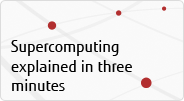- The possibilities
- About K computer
- Global Challenge and Fujitsu
- Quick guide to supercomputing
- Look into the K computer
- Supercomputing explained in three minutes
- Events
- Topics
- Brochures
- Links
Archived content
NOTE: this is an archived page and the content is likely to be out of date.
Quick guide to supercomputing

Throughout the ages, humans have always sought to understand the world around them, often using tools to adapt to their environment and solve problems. As the challenges facing humans have become more sophisticated, so too have the tools they use. Early stone hammers have ultimately given way to ultra-high-speed supercomputers. These supercomputers are being used to address many of the pressing challenges facing society today...
Questions
- What is a supercomputer?
- What is a supercomputer used for?
- Are there any other applications for supercomputers?
- Who developed the world's first supercomputer?
- How many supercomputers are there in the world?
- What makes a supercomputer fast?
- What data is communicated between the CPUs?
- Why do CPUs get hot?
- Where is the K computer?
- What are petaflops (PFLOPS)?
- How many people were involved in the development of the K computer?
- How much power does the Supercomputer "K computer" consume?
What is a supercomputer?
A supercomputer is able to perform advanced scientific and technical calculations quickly and on a scale that would be difficult to achieve using regular computers. Supercomputers are mainly used by research institutions and industrial companies.
What is a supercomputer used for?
The world faces a variety of problems that are complex and difficult to solve quickly. These include the need to conserve resources, protect the environment and develop new medical therapies. Supercomputers perform calculations at super-high speeds, processing massive amounts of information. This allows them to recreate or model a wide variety of phenomena inside the computer, such as the unobservable internal structure of the earth, large-scale disasters that cannot be reproduced and the effects of pharmaceuticals on the human body that are not clearly understood. These models give scientists unique insights into these events and phenomena. This process is called computer simulation, and has become the third pillar of science, flanking theory and experiments. Supercomputers have become an essential tool in all fields of research and development, supporting everything from fundamental research right up to manufacturing.
Are there any other applications for supercomputers?
Leading-edge simulations using supercomputing power are widely used in a variety of fields beyond research. Common applications include forecasting share prices in financial transactions, creating animations in computer graphics, developing swimwear with lower resistance for competitive swimming, developing washing machines that remove dirt using less water and designing equipment for manufacturing potato chips.
Who developed the world's first supercomputer?
Computers were originally developed to perform scientific and technical calculations. In other words, the first generation of computers were what we now call supercomputers. The very first computer was ENIAC, which was created in the USA in 1946. ENIAC was developed for military purposes, and was mainly used for calculating the ballistics of artillery. The first computer in the world to be referred to as a supercomputer was the "CDC6600" developed in 1964 by Seymour Cray, who is known as the "father of supercomputing".
How many supercomputers are there in the world?
Supercomputers are currently used for a wide range of applications by research institutions and industrial corporations. They range in size from super-large scale to small-scale devices. There are so many supercomputers in use today that it is extremely difficult to know the exact number.
What makes a supercomputer fast?
Most modern supercomputers are equipped with a large number of CPUs.
There are two key speed factors:
1) each CPU must perform calculations quickly and
2) data must be exchanged quickly between the CPUs.
The speed of each CPU can be accelerated by increasing the operating frequency, increasing the number of cores, increasing the number of internal computation units and supplying the required data at high speed. Data exchange between the CPUs is accelerated by developing fast inter-CPU networks and developing interconnect technology.
Both the software and hardware must be optimized for high speed.
What data is communicated between the CPUs?
The information (or data) needed to perform a calculation is communicated between the CPUs.
For example, consider a weather forecasting computer simulation in which the region being forecast is divided into a fine grid of cells, with the calculations for each cell performed by a single CPU responsible for that cell. In this situation, the next state is calculated by comparing meteorological conditions such as the temperature in the neighboring cells. In a supercomputer, a single job is tackled by dividing it up among a large number of CPUs. Data is communicated between the CPUs so each CPU can find out what the other CPUs are doing and tell the other CPUs what it is doing.
Why do CPUs get hot?
Internally, a CPU contains many components that are made of semiconductor materials and metal. When electrical current flows through the CPU in order to perform a calculation, heat is generated by the electrical resistance (resistance to the flow of electrical current) of these components and wiring. That is what makes the CPU hot.
Where is the K computer?
The K computer is located in Japan on an artificial island called Port Island in Kobe city in the Hyogo prefecture. The decision to pick Kobe from the 15 candidate locations across Japan was made in March 2007 as the result of an investigation that took more than 6 months. The investigative team looked at a variety of factors, including the effects of natural disasters, stability of the electrical power supply, cost of outfitting and running the facilities, ease of access and quality of infrastructure to support a research and education center.
What are petaflops (PFLOPS)?
FLOPS means floating-point operations per second. It is used to express the processing power of a computer. FLOPS can be prefixed by various letters to indicate the following orders of magnitude:
・1 G(giga = 10 9)FLOPS: 1,000,000,000 calculations per second
・1 T(tera = 10 12)FLOPS: 1,000,000,000,000 calculations per second
・1 P(peta = 10 15)FLOPS: 1,000,000,000,000,000 calculations per second
The K computer is capable of handling 10,000,000,000,000,000 (10 quadrillion) calculations per second (10 petaflops = 10 16), which corresponds to one "kei" in Japanese. Which is why it was called the K computer.
How many people were involved in the development of the K computer?
The K computer was developed in partnership between RIKEN and Fujitsu with over 1,000 people involved in the project.
How much power does the Supercomputer "K computer" consume?
A lot of electrical power is needed to run a supercomputer.
The electrical power used by the Supercomputer "K computer" when measuring the benchmark for TOP500 list in November 2011 was 12.65989 MW/h. Considering that average power used per hour by a typical household is 400 W/h, the power used by the K computer is equivalent to approximately 30,000 homes.
However, the performance per unit of power is in the top class among the supercomputers in the world, and the K computer can be said to be a computer that has high environmental performance.




